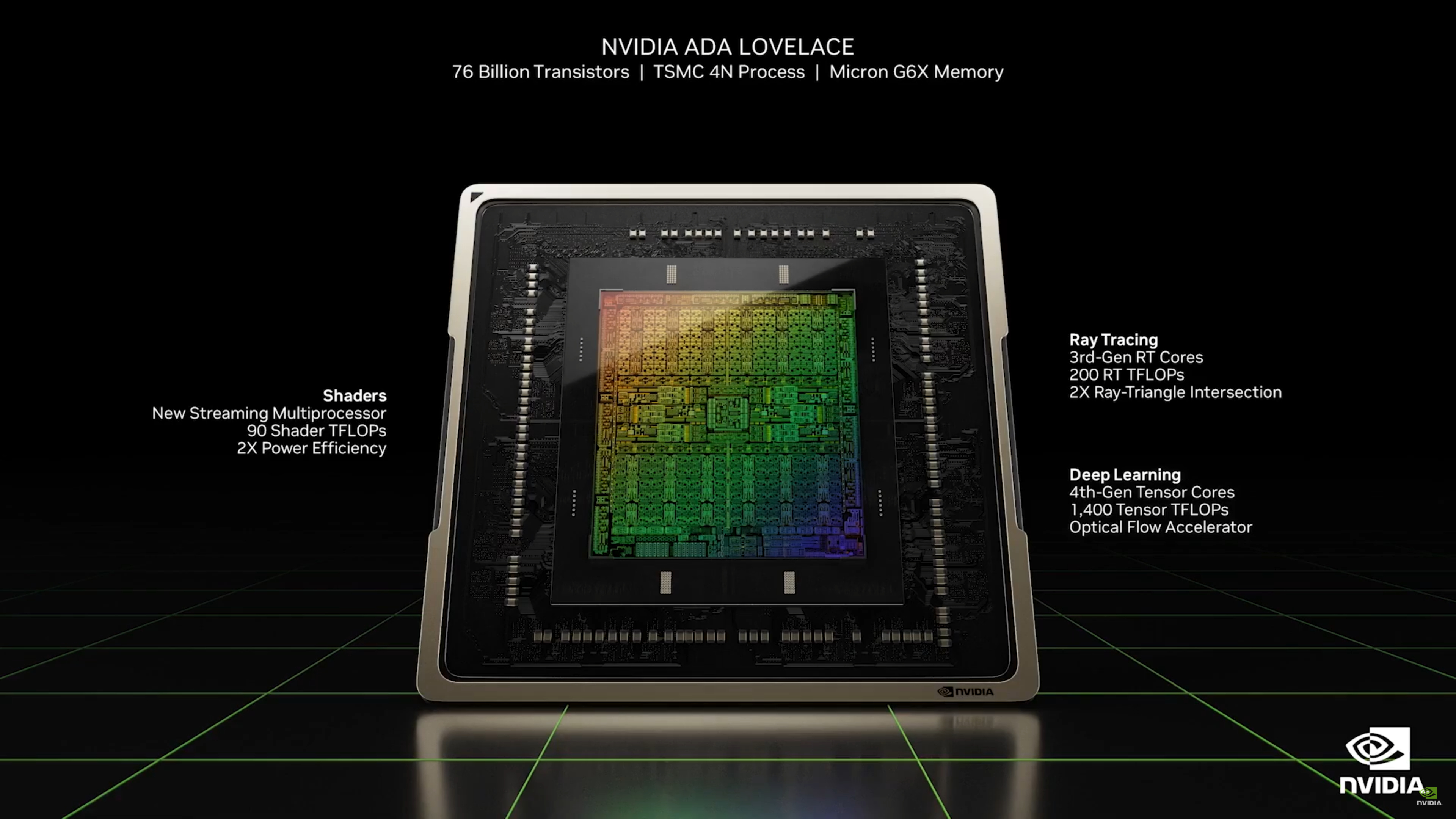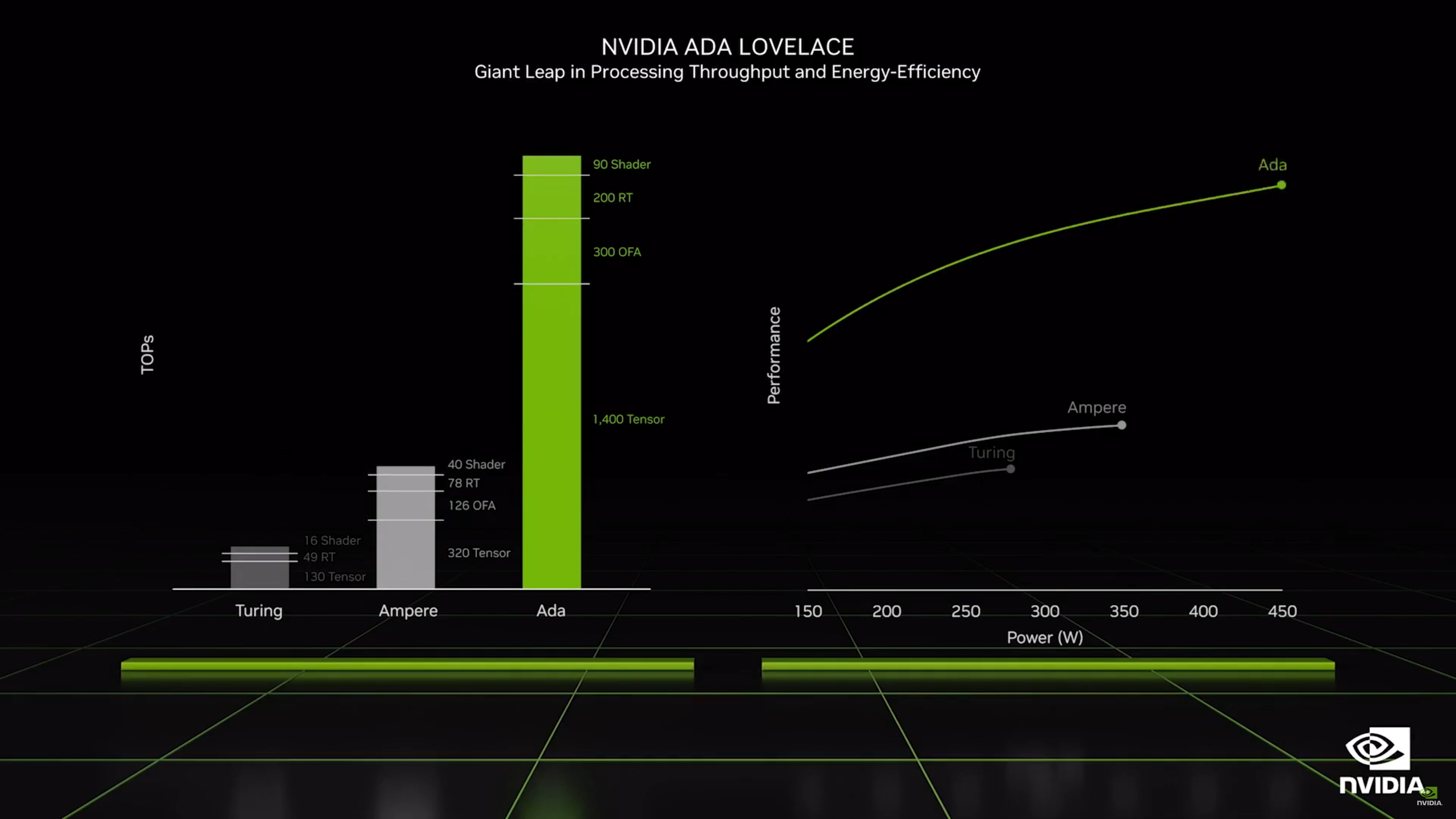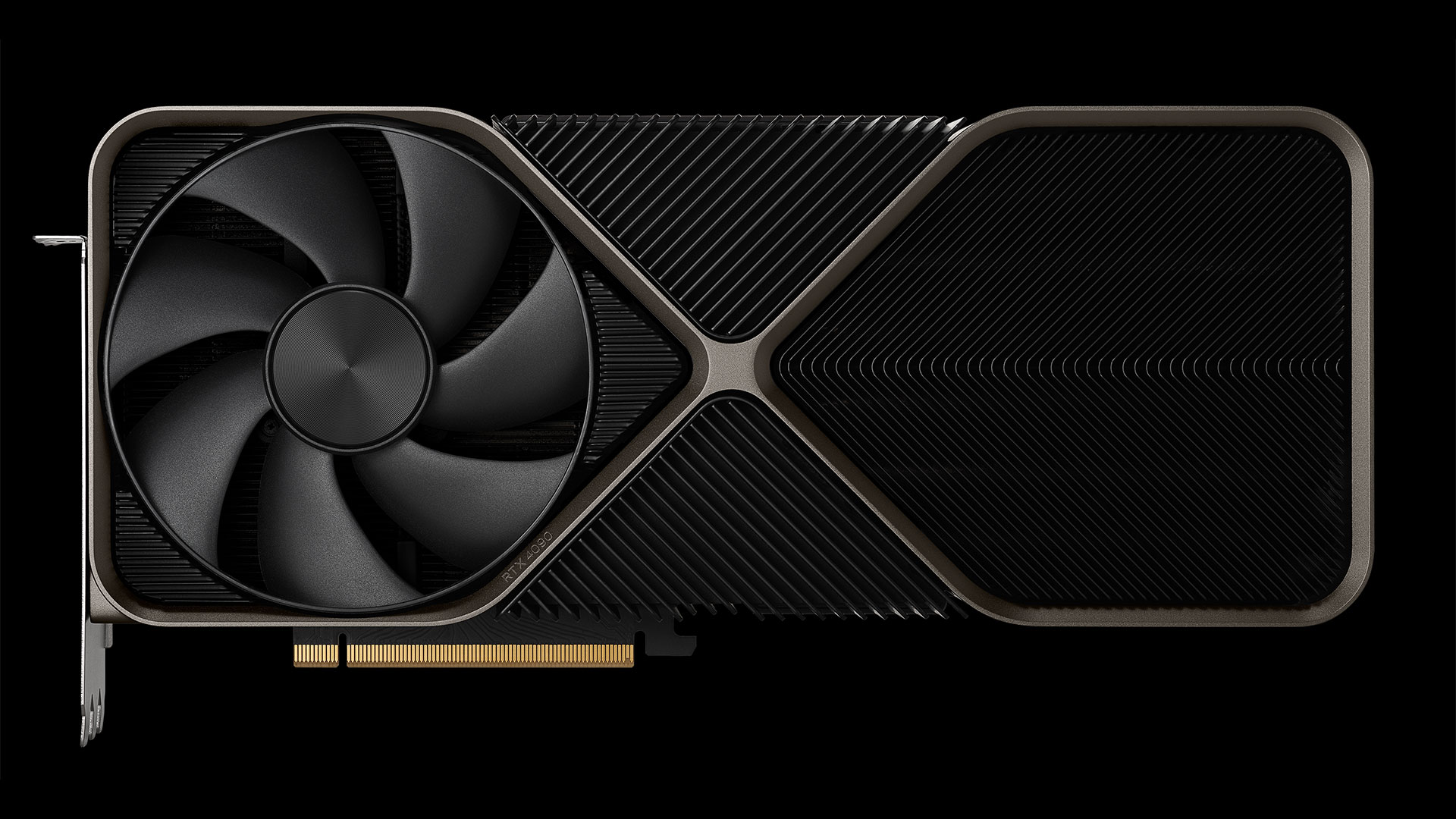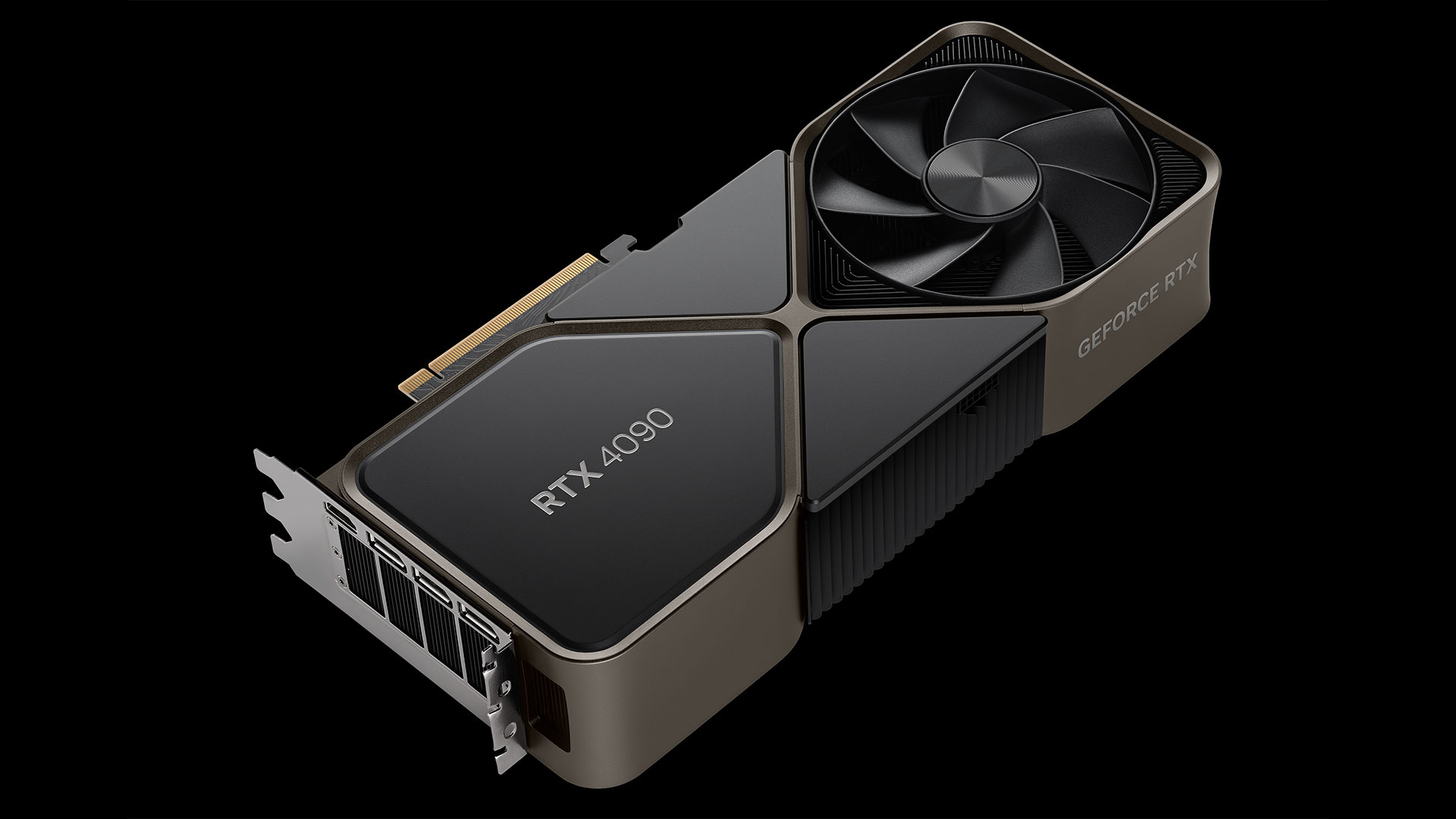Nvidia's Ada architecture and GeForce RTX 40-series graphics cards first started shipping on October 12, 2022, starting with the GeForce RTX 4090. The GeForce RTX 4080 followed one month later on November 16, 2022, then the RTX 4070 Ti (formerly RTX 4080 12GB) launched on January 5, 2023, and most recently was the RTX 4070 launch on April 13. That's two years after the Nvidia Ampere architecture and basically right on schedule given the slowing down (or if you prefer, death) of Moore's 'Law.' It's also great news as the best graphics cards were in need of some new competition.
With the Nvidia hack early in 2022, we had a good amount of information on what to expect. Cards are now shipping and Nvidia has confirmed specs on the many of the RTX 40-series cards. We've collected everything into this central hub detailing everything we know and expect from Nvidia's Ada architecture and the RTX 40-series family.
There are still rumors swirling around, mostly concerning future Ada Lovelace cards like the rumored Titan RTX Ada / RTX 4090 Ti, and the lower tier models like the RTX 4060-class and RTX 4050 — and those lower spec GPUs are already shipping in the Nvidia RTX 40-series mobile solutions. But model numbers notwithstanding, we now have a good idea of what we can expect from the Ada Lovelace architecture. With the Ada whitepaper now available alongside the GPUs, we've updated the information here to cover exactly what the new generation of GPUs delivers.
The first salvo of desktop RTX 40-series cards have launched. If Nvidia follows a similar release schedule as in the past, we can expect the rest of the RTX 40-series to trickle out over the next year. The RTX 4060 Ti should arrive in May, with alternative RTX 4060 Ti 16GB and RTX 4060 models in July, and finally there will (maybe?) be an 4050 sometime this summer. Let's start with the high level overview of the specs and rumored specs for the Ada series of GPUs.
GeForce RTX 40-Series Specs and Speculation
The RTX 4090, 4080, 4070 Ti, and 4070 cards are now official and the specs are fully accurate. There are solid rumors for the RTX 4060 Ti and 4060, while the RTX 4050 is largely based on what we know of the mobile RTX 4050. In other words, apply salt generously on the RTX 4090 Ti and/or Titan and 4050 cards, as they're more speculation than anything concrete. Nvidia hasn't officially revealed even the existence of these cards, and it won't until they're closer to release.
There will also likely be additional cards announced in the future, for the mid-cycle update (i.e. similar to the 3080 Ti and 3070 Ti, or prior to that the 2080/2070/2060 Super models).
Certainly, there's plenty of room at the top for a future RTX 4090 Ti. Note that the maximum L2 cache is cut down on the 4090 (six blocks of 12MB instead of six blocks of 16MB), ROPs are trimmed a bit, and Nvidia could certainly push higher on clocks and power... and price. [Sigh.] But while credible rumors of a 4-slot Founders Edition card have been circulating, nothing is official at present.
We do know that Nvidia is hitting clock speeds of 2.5–2.6 GHz on the 4090, 4080, and 4070 Ti, and we expect similar clocks on the other GPUs in the RTX 40-series. Official specs and real-world clocks aren't the same thing, however, as the RTX 4070 for example lists a 2475 MHz boost clock while in testing the RTX 4070 Founders Edition routinely broke 2700 MHz. Nvidia has also successfully overclocked RTX 4090 to 3.0GHz and beyond. We've put in tentative clock speed estimates of around 2.5~2.6 GHz on the unannounced GPUs for now.
The four released models are also using three different GPUs, which is a change from previous launches. RTX 4090 uses a significantly trimmed down AD102 implementation (89% of the cores, 75% of the cache). Meanwhile, RTX 4080 uses an "almost complete" AD103 chip (95% of the cores and all the cache), RTX 4070 Ti uses a fully enabled AD104 chip, and RTX 4070 uses 77% of an AD104 chip. Again, we can expect either harvested or more fully enabled variants of each GPU at some point.
Nvidia "went big" with the AD102 GPU, and it's closer in size and transistor counts to the H100 than GA102 was to GA100. Frankly, it's a monster, with performance and price to match. It packs in far more SMs and the associated cores than any Ampere GPUs, it has much higher GPU clocks, and it also contains a number of architectural enhancements to further boost performance. Nvidia claimed that the RTX 4090 is 2x–4x faster than the outgoing RTX 3090 Ti, though caveats apply to those benchmarks.
Our own testing puts performance at more like 60% faster in aggregate compared to the previous generation RTX 3090 Ti. That's at 4K and maxed out settings, without DLSS 2 or DLSS 3. But as we noted in our reviews, while DLSS 3 Frame Generation can boost frame rates, it's not the same as "real" frames and it typically adds latency, meaning it feels more like a 10–20 percent improvement over the baseline performance. It's also worth noting that if you're currently running a more modest processor rather than one of the absolute best CPUs for gaming, you could very well end up CPU limited even at 1440p ultra with the 4090. A larger system upgrade will likely be necessary to get the most out of the fastest Ada GPUs.
TSMC 4n: "4nm Nvidia"

Nvidia will most likely use TSMC's 4N process — "4nm Nvidia" — on all of the Ada GPUs, and it's definitely used on the launched cards. We know for certain that AD102, AD103, and AD104 along with Hopper H100 use TSMC's 4N node, a tweaked variation on TSMC's N5 node that's been widely used in other chips and which is also used for AMD's Zen 4 and RDNA 3. We don't think Samsung will have a compelling alternative that wouldn't require a serious redesign of the core architecture, so the whole family will likely be on the same node.
TSMC N4 offers several major improvements over the Samsung 8N ("8nm Nvidia") used on Ampere. Specifically, it has much smaller features, meaning Nvidia can pack in a lot more transistors in a similar or smaller area. AD102 for example has 76.3 billion transistors in a 608mm^2 die size, or on average roughly 125 million transistors per square millimeter. AD103 and AD104 offer a similar 121 million transistors per square mm. The Ampere GA102/104/106 GPUs by comparison packed around 43~45 million transistors per mm^2.
The N4 process node also allows for lower power use and improved efficiency. Yes, the RTX 4090 has a massive 450W TGP (total graphics power) budget, but on average, across a 15 game test suite, it averaged 390W at 4K ultra settings. The most demanding games could pull 450W, while others only needed around 300~325 watts. And that's the worst example from Ada; the RTX 4080, 4070 Ti, and 4070 are all at the top of our efficiency metric, in terms of FPS per watt.
Finally, as noted above, clock speeds are much higher with Ada than with Ampere. Official clocks have increased from 1,665–1,860 MHz with Ampere (depending on the model), to a range of 2,475–2,610 MHz with Ada. That's on average 40 to 50 percent higher clocks, though the real-world clocks for both Ampere and Ada tend to be around 200 MHz higher than the official boost clocks.
Ada Massively Boosts Compute Performance

With the high-level overview out of the way, let's get into the specifics. The most noticeable change with Ada GPUs will be the number of SMs compared to the current Ampere generation. At the top, AD102 potentially packs 71% more SMs than the GA102. Even if nothing else were to significantly change in the architecture, we would expect that to deliver a huge increase in performance.
That will apply not just to graphics but to other elements as well. Most of the calculations haven't changed from Ampere, though the Tensor cores now support FP8 (with sparsity) to potentially double the FP16 performance. Each 4th generation Tensor core can perform 256 FP16 calculations per clock, double that with sparsity, and double that again with FP8 and sparsity. The RTX 4090 has theoretical deep learning/AI compute of up to 661 teraflops in FP16, and 1,321 teraflops of FP8 — and a fully enabled AD102 chip could hit 1.4 petaflops at similar clocks.
The full GA102 in the RTX 3090 Ti by comparison tops out at around 321 TFLOPS FP16 (again, using Nvidia's sparsity feature). That means RTX 4090 delivers a theoretical 107% increase, based on core counts and clock speeds. The same theoretical boost in performance applies to the shader and ray tracing hardware as well, except those are also changing.
The GPU shader cores will have a new Shader Execution Reordering (SER) feature that Nvidia claims will improve general performance by 25%, and can improve ray tracing operations by up to 200%. Unfortunately, support for SER will require developers to use proprietary Nvidia extensions, so existing games won't necessarily benefit.
The RT cores meanwhile have doubled down on ray/triangle intersection hardware (or at least the throughput per core), plus they have a couple more new tricks available. The Opacity Micro-Map (OMM) Engine enables significantly faster ray tracing for transparent surfaces like foliage, particles, and fences. The Displaced Micro-Mesh (DMM) Engine on the other hand optimizes the generation of the Bounding Volume Hierarchy (BVH) structure, and Nvidia claims it can create the BVH up to 10x faster while using 20x less (5%) memory for BVH storage. Again, these require that developers make use of the new features, so existing ray tracing games won't benefit without a patch.
Together, these architectural enhancements should enable Ada Lovelace GPUs to offer a massive generational leap in performance. Except it will be up to developers to enable most of them, so uptake might be rather diminished.
Ada Lovelace ROPs
Ada's ROP counts are going up quite a bit in some cases, particularly the top model (for now) RTX 4090. As with Ampere, Nvidia ties the ROPs to the GPCs, the Graphics Processing Clusters, but some of these can still be disabled. Each GPC typically gets 16 ROPs.
The AD102 has up to 144 SMs with 12 GPCs of 12 SMs each. That yields 192 ROPs as the maximum, though the final number on the RTX 4090 is 11 GPCs and 176 ROPs. RTX 4080 gas seven GPCs, just like GA102, though in an odd change of pace it appears one of the GPC clusters only has 8 SMs while the other six have up to 12 SMs. Regardless, all seven are enabled on the RTX 4080 and it has 112 ROPs. AD104 in the RTX 4070 Ti and 4070 uses five GPCs of 12 SMs, with 80 ROPs.
For the time being, the remaining cards should be taken as a best guess. We don't know for certain what GPUs will be used, or how many GPCs will be active on each. We'll fill in the blanks as more information becomes available in the coming months, once the other Ada GPUs have launched.
Memory Subsystem: GDDR6X Rides Again

Last year, Micron announced it has roadmaps for GDDR6X memory running at speeds of up to 24Gbps. The latest RTX 3090 Ti only uses 21Gbps memory, and Nvidia is currently the only company using GDDR6X for anything. That immediately raises the question of what will be using 24Gbps GDDR6X, and the only reasonable answer seems to be Nvidia Ada. The lower-tier GPUs are more likely to stick with standard GDDR6 rather than GDDR6X as well, which tops out at 20Gbps and is used in AMD's RX 7900 XTX/XT cards.
Officially, the RTX 4090, 4070 Ti, and 4070 all use 2GB chips rated for 21Gbps. The RTX 4080 is the exception, featuring 2GB chips rated for 22.4Gbps. Except, Micron doesn't make 22.4Gbps chips, so they're actually 24Gbps chips that are clocked more conservatively. Anecdotally, in our disassembly of multiple RTX 40-series GPUs, we've noticed that some of the "21Gbps" cards have memory that runs cooler and overclocks better, hitting up to 25Gbps. We assume Micron is just down-binning some chips and that yields on the 24Gbps memory are quite good now.
Having the same peak bandwidth as the RTX 3090 Ti represents a bit of a problem, as GPUs generally need compute and bandwidth to scale proportionally to realize the promised amount of performance. The RTX 3090 Ti for example has 12% more compute than the 3090, and the higher clocked memory provides 8% more bandwidth. Based on the compute details shown above, there's a huge disconnect brewing. The RTX 4090 has around twice as much compute as the RTX 3090 Ti, but it offers the same 1008 GB/s of bandwidth — 24Gbps for an eventual RTX 4090 Ti, anyone?
There's far more room for bandwidth to grow on the lower tier GPUs, assuming GDDR6X power consumption can be kept in check. The current RTX 3050 through RTX 3070 all use standard GDDR6 memory, clocked at 14–15Gbps. We already know GDDR6 running at 20Gbps is available, so a hypothetical RTX 4050 with 18Gbps GDDR6 ought to easily keep up with the increase in GPU computational power. If Nvidia still needs more bandwidth, it could tap GDDR6X for the lower tier GPUs as well.
The catch is that Nvidia doesn't need massive increases in pure memory bandwidth, because instead it reworked the architecture, similar to what we saw AMD do with RDNA 2 compared to the original RDNA architecture. Namely, it will pack in a lot more L2 cache to relieve the demands on the memory subsystem.
Ada Cashes in on L2 Cache
One great way of reducing the need for more raw memory bandwidth is something that has been known and used for decades. Slap more cache on a chip and you get more cache hits, and every cache hit means the GPU doesn't need to pull data from the GDDR6/GDDR6X memory. A large cache can be particularly helpful for gaming performance. AMD's Infinity Cache allowed the RDNA 2 chips to basically do more with less raw bandwidth, and the Nvidia Ada L2 cache shows Nvidia has taken a similar approach.
AMD uses a massive L3 cache of up to 128MB on the Navi 21 GPU, with 96MB on Navi 22, 32MB on Navi 23, and just 16MB on Navi 24. AMD also has 96MB of L3 cache on the new Navi 31. Surprisingly, even the smaller 16MB cache does wonders for the memory subsystem. We didn't think the Radeon RX 6500 XT was a great card overall, but it basically keeps up with cards that have almost twice the memory bandwidth.
The Ada architecture pairs up to an 8MB L2 cache with each 32-bit memory controller, or 16MB per 64-bit controller. That means the cards with a 128-bit memory interface would get 32MB of total L2 cache, and the 384-bit interface on AD102 has up to 96MB of L2 cache. Except, part of the L2 cache blocks can also be disabled, so the RTX 4090 only has 72MB of L2 cache (twelve blocks of 6MB instead of 8MB), and some of the other Ada models will likely take a similar approach.
While that's less than AMD's RDNA 2 Infinity Cache in many cases, AMD also dropped to 96MB total L3 cache for its top RX 7900 XTX. We also don't know latencies or other aspects of the design yet. L2 cache tends to have lower latencies than L3 cache, so a slightly smaller L2 could definitely keep up with a larger but slower L3 cache, and as we saw with RDNA 2 GPUs, even a 16MB or 32MB Infinity Cache helped a lot.
If we look at AMD's RX 6700 XT as an example. It has about 35% more compute than the previous generation RX 5700 XT. Performance in our GPU benchmarks hierarchy meanwhile is about 32% higher at 1440p ultra, so performance overall scaled pretty much in line with compute. Except, the 6700 XT has a 192-bit interface and only 384 GB/s of bandwidth, 14% lower than the RX 5700 XT's 448 GB/s. That means the big Infinity Cache gave AMD at least a 50% boost to effective bandwidth.
In general, it looks like Nvidia gets similar results with Ada, and even without wider memory interfaces the Ada GPUs should still have plenty of effective bandwidth. It's also worth mentioning that Nvidia's memory compression techniques in past architectures have proven capable, so slightly smaller caches compared to AMD may not matter at all.
RTX 40-Series Gets DLSS 3



One of the big announcements with the RTX 40-series and Ada Lovelace is DLSS 3, which will only work with RTX 40-series graphics cards. Where DLSS 1 and DLSS 2 work on both RTX 20- and 30-series cards, and will also work on Ada GPUs, DLSS 3 fundamentally changes some things in the algorithm and apparently requires the new architectural updates.
Inputs to the DLSS 3 algorithm are mostly the same as before, but now there's an updated Optical Flow Accelerator (OFA) that takes two prior frames and generates additional motion vectors that can then feed into the Optical Multi Frame Generation unit. Combined with DLSS performance mode upscaling, Frame Generation means the GPU potentially only has to actually render 1/8 of the pixels that get sent to the screen.
Incidentally, the OFA is not new with Ada. Turing and Ampere also had a fixed function OFA block, only it wasn't as performant or as capable. Typical use cases for OFA in the past included reducing latency in augmented and virtual reality, improving smoothness of video playback, enhancing video compression efficiency, and enabling video camera stabilization. It was also used with automotive and robotic navigation, and video analysis and understanding.
The Ampere generation upgraded the OFA to a 126 teraops (INT8) fixed function unit, and now Ada boosts the OFA up to 305 teraops. The added performance and other enhancements allow it to be used to create the optical flow field that’s part of DLSS 3 Frame Generation. While the higher performance and capabilities of the Ada OFA are currently required for DLSS 3, there’s a bit of wiggle room. Nvidia’s Bryan Catanzaro, VP of Applied Deep Learning Research, tweeted that it was “theoretically possible” for DLSS 3 to eventually work on Ampere GPUs. It would likely run at lower quality and performance levels, however, and it may never actually happen.
We've now had a chance to see how DLSS 3 looks and feels in action. It's not quite as amazing as Nvidia's claims. Because there's no additional user input factored into the calculated frames, plus the extra two frames of latency (relative to the generated frame rate), DLSS 3 can look better than it feels. Take a game like A Plague Tale: Requiem running at 100 fps with DLSS 2 upscaling, and Frame Generation can boost that to 140–150 fps... but it feels more like maybe 110–120 fps at best, in our opinion.
DLSS 3 currently requires RTX 40-series cards to run, at least with Frame Generation enabled. That will be an extra setting users can choose to enable; without that, DLSS 3 still supports the core DLSS 2 upscaling algorithm and also requires that developers use Nvidia Reflex, so developers opting for DLSS 3 support RTX 40-series as well as previous RTX series cards.
Ada Gets AV1 Encoding, Times Two
Nvidia announced that the GeForce RTX 4090, 4080, and 4070 Ti graphics cards will feature two of its eighth-generation Nvidia Encoder (NVENC) hardware units. These will also have support for AV1 encoding, similar to Intel Arc — except there are two instead of just one. We've recently conducted in-depth testing of video encoding performance and quality, comparing the latest GPUs to previous generations.
AV1 encoding improves efficiency by 40% according to Nvidia, but that appears to be compared with H.264 (it's mostly similar in bitrates and efficiency to HEVC/H.265). That means any livestreams that support the codec would look as if they had a 40% higher bitrate than the current H.264 streams. Of course, the streaming service will need to support AV1 for this to matter.
The two encoders can split up work between them, so encoding performance is potentially doubled for any workload, even if the GPU is only encoding a single stream. Or at least that's the theory; in practice, we didn't see any major change when using ffmpeg compared to previous NVENC speeds. Video editors can benefit from the performance boost, and Nvidia worked with DaVinci Resolve, Handbrake, Voukoder, and Jianying to enable support.
GeForce Experience and ShadowPlay will also use the new hardware, allowing gamers to capture gameplay at up to 8K and 60 fps in HDR. Perfect for the 0.01% of people that can view native 8K content! (If you build it, they will come...) Also, the NVENC units can still handle H.264, HEVC, and other formats just fine.
Ada Power Consumption

Early reports of 600W and higher TBPs (Total Board Power) for Ada appear to be mostly unfounded, at least on the announced Founders Edition models. In fact, after testing six different RTX 4090 cards, even with manual overclocking we didn't consistently break 600W. The RTX 4090 has the same 450W TGP as the outgoing RTX 3090 Ti, while the RTX 4080 drops that to just 320W, the RTX 4070 Ti has a 285W TGP, and RTX 4070 lands at 200W. Those are for the reference Founders Edition models, however.
As we've seen with RTX 3090 Ti and other Ampere GPUs, some AIB (add-in board) partners are more than happy to have substantially higher power draw in pursuit of every last ounce of performance. RTX 4090 custom cards that draw up to 600W certainly aren't out of the question, and a future RTX 4090 Ti could push that even higher.
It all goes back to the end of Dennard scaling, right along with the death of Moore's Law. Put simply, Dennard scaling — also called MOSFET scaling — observed that with every generation, dimensions could be scaled down by about 30%. That reduced overall area by 50% (scaling in both length and width), voltage dropped a similar 30%, and circuit delays would decrease by 30% as well. Furthermore, frequencies would increase by around 40% and total power consumption would decrease by 50%.
If that all sounds too good to be true, it's because Dennard scaling effectively ended around 2007. Like Moore's Law, it didn't totally fail, but the gains became far less pronounced. Clock speeds in integrated circuits have only increased from a maximum of around 3.7GHz in 2004 with the Pentium 4 Extreme Edition to today's maximum of 5.5GHz in the Core i9-12900KS. That's still almost a 50% increase in frequency, but it's come over six generations (or more, depending on how you want to count) of process node improvements. Put another way, if Dennard scaling hadn't died, modern CPUs would clock as high as 28GHz. RIP, Dennard scaling, you'll be missed.
It's not just the frequency scaling that died, but power and voltage scaling as well. Today, a new process node can improve transistor density, but voltages and frequencies need to be balanced. If you want a chip that's twice as fast, you might need to use nearly twice as much power. Alternatively, you can build a chip that's more efficient, but it won't be any faster. Nvidia seems to be going after more performance with Ada, though it hasn't completely tossed efficiency concerns out the window.
Just look at the RTX 4070 Ti as an example. Nvidia suggests it's close to the previous generation RTX 3090 Ti in performance, while drawing 37% less power. In some cases, like with DLSS 3 and heavy RT workloads, it can even double the performance while still using less power. In our actual testing of the 4070 Ti, we found it was generally about as fast as an RTX 3090 when DLSS 3 wasn't used, but power was still noticeably lower.
How Much Will RTX 40-Series Cards Cost?

The short answer, and the true answer, is that they will cost as much as Nvidia and retailers can get away with charging. Nvidia launched Ampere with one set of financial models, and those proved to be completely wrong for the Covid pandemic era. Real-world prices shot up and scalpers profiteered, and that was before cryptocurrency miners started paying two to three times the official recommended prices.
The good news is that GPU prices are coming down, and Ethereum mining has ended. That in turn has absolutely killed GPU profitability for mining, with most cards now costing more to run than they could make off the endeavor. That's all great to hear, but it still doesn't guarantee reasonable prices.
What do you do when you have a bunch of existing cards to sell? You make the new cards cost more. We're seeing that with the launch prices on the RTX 4090, 4080, and 4070 Ti models. The 4090 is $1,599, $100 more than the 3090 launch price and far out of reach of most gamers. The RTX 4080 isn't much better at $1,199, and the RTX 4070 Ti costs $799, $100 more than the RTX 3080 10GB launch MSRP and $200 more than the outgoing RTX 3070 Ti — and it wasn't until late 2022 that we even saw 30-series cards sell at retail for close to their MSRPs!
Ultimately, it looks like Nvidia has managed to clear out enough of its existing RTX 30-series inventory (or is simply refusing to lower prices) that the RTX 40-series cards are maintaining their high prices. Most are now available starting at MSRP, or at least close to it, though the RTX 4090 can still command a premium. That's likely because it's also being picked up for professional work, including AI and deep learning research.
So, generational GPU prices are going up with Ada and the RTX 40-series. Nvidia also has to compete with AMD and the Radeon RX 7000-series and RDNA 3 GPUs, but those are also expensive. Nvidia was slow to push out additional GPUs like the RTX 4070 and below, though the 4060 Ti and below may get back to price parity with their predecessors. Hopefully the future models will continue to trend downward and reach more reasonable levels of cost without totally axing performance.
Founders Edition Design Changes

Nvidia made a lot of claims about its new Founders Edition card design at the launch of the RTX 3080 and 3090. While the cards generally work fine, what we've discovered over the past two years is that traditional axial cooling cards from third party AIC partners tend to cool better and run quieter, even while using more power. The GeForce RTX 3080 Ti Founders Edition was a particularly egregious example of how temperatures and fan speeds couldn't keep up with hotter running GPUs.
The main culprit seems to be the GDDR6X memory, and Nvidia won't be packing more GDDR6X into Ada than in Ampere, at least in terms of the total number of chips. However, Nvidia does note that it has worked with Micron (the exclusive manufacturer of GDDR6X) to reduce power consumption from the latest generation chips. That should certainly help matters, and while Micron does make 24Gbps GDDR6X, so far Nvidia isn't going that high on memory clocks.
RTX 4090 will have twelve 2GB chips, just like the 3090 Ti, while the 4080 cuts that to eight chips and the 4070 Ti only has to cool six chips. With a process shrink from Micron on the GDDR6X chips, plus better thermal pads, we get RTX 40-series cards that generally don't run nearly as hot as the previous models. Nvidia also reduced thermal pad thickness with the RTX 40-series to better aid in heat transfer from the memory to the heatsink.
It's interesting to note that of the six RTX 4090 cards we tested, about half came with a different class of GDDR6X memory. These cards tended to show VRAM temperatures peaking at 65–70 degrees Celsius, while the other cards would reach 80–85C. Our assumption is that the lower temperature cards are actually using Micron's 24Gbps chips with an improved process node, just marked and sold as 21Gbps. The RTX 4080 so far is the only card to require faster chips, and those cards also tend to hit <65C on the VRAM. The other models seem to be using the same 2GB chips as the RTX 3090 Ti.
As for card designs, even the RTX 4080 gets in on the triple-slot action this round, which is an interesting change of pace. It's 'only' a 320W TBP, but then the 3080 FE and 3080 Ti FE always ran more than a little toasty. The 285W TBP on the 4070 Ti may get the two-slot treatment from some of the AIB partners, but Nvidia won't be making a 4070 Ti Founders Edition — that particular GPU will only come from third party cards. The RTX 4070 does have a Founders Edition, and we expect at least one variant of the RTX 4060 Ti to be a Founders Edition as well.
Ada GPU Release Dates
Now that the big reveal and initial launches are over, we know that the RTX 4090 arrived on October 12, the RTX 4080 launched on November 16, and the RTX 4070 Ti arrived on January 5 (after changing the name from RTX 4080 12GB and dropping the MSRP $100), and the RTX 4070 landed on April 13. Beyond that, however, there will be plenty of other Ada graphics cards.
Nvidia launched the RTX 3080 and RTX 3090 in September 2020, the RTX 3070 arrived one month later, then the RTX 3060 Ti arrived just over a month after that. The RTX 3060 didn't come out until late February 2021, then Nvidia refreshed the series with the RTX 3080 Ti and RTX 3070 Ti in June 2021. The budget-friendly RTX 3050 didn't arrive until January 2022, and finally the RTX 3090 Ti launched at the end of March 2022.
We expect a staggered launch for the Ada cards as well, perhaps delayed to allow the oversupply situation Nvidia was currently facing on RTX 30-series parts in 2022 to correct. When will the 4060 and 4050 come out? We're hearing July for the vanilla 4060, but there's no word on the 4050 yet.
We still need true budget offerings to take over the GTX 16-series. Could we get a new GTX series, or a true budget RTX card for under $200? It's possible, but don't count on it, as Nvidia seems content to let AMD and Intel fight it out in the sub-$200 range. At best, RTX 3050 might drop to $200 in the coming months, but we wouldn't be surprised to see Nvidia completely abandon the sub-$200 graphics card market. We suspect the RTX 4050, whenever if arrives, will take over the $250 price point.
There will inevitably be a refresh of the Ada offerings about a year after the initial launch as well, and we're getting close to that mark now. Whether those end up being "Ti" models or "Super" models or something else is anyone's guess, but you can pretty much mark it on your calendar. GeForce RTX 40-series refresh, coming in the fall of 2023.
More Competition in the GPU Space

Nvidia has been the dominant player in the graphics card space for a couple of decades now. It controls roughly 80% of the total GPU market, and 90% or more of the professional market, which has largely allowed it to dictate the creation and adoption of new technologies like ray tracing and DLSS. However, with the continuing increase in the importance of AI and compute for scientific research and other computational workloads, and their reliance on GPU-like processors, numerous other companies are looking to break into the industry, chief among them being Intel.
Intel hasn't made a proper attempt at a dedicated graphics card since the late 90s, unless you count the aborted Larrabee. This time, Intel Arc Alchemist appears to be the real deal — or at least the foot in the door. Intel focused more on media capabilities, and Arc's gaming and general compute performance are okay but certainly not sufficient to compete with high-end cards. Instead, Intel is going for the mainstream to budget sector... for now.
But Arc Alchemist is merely the first in a regular cadence of GPU architectures that Intel has planned. Battlemage could easily double down on Alchemist's capabilities, and if Intel can get that out sooner than later, it could start to eat into Nvidia's market share, especially in the gaming laptop space. JPR indicates Arc achieved a rather impressive 6% of the global sell-in market at the end of 2023, but dropping prices suggest the sell-out for Arc isn't nearly as high.
AMD won't be standing still either, and it successfully launched its RDNA 3 architecture in December 2022. AMD has moved to TSMC's N5 node for the GPU chiplets, but it will also use the N6 node for the memory chiplets. AMD still refuses to put any significant amount of deep learning hardware into its consumer GPUs (unlike its MI200 series), however, which allows it to focus on delivering performance without worrying as much about upscaling — though FSR 2.0 does cover that as well and works on all GPUs. But in the AI space, that means AMD's consumer GPUs are falling behind.
There's also no question that Nvidia currently delivers far superior ray tracing performance than AMD's RX 7000- and 6000-series cards. AMD hasn't been nearly as vocal about ray tracing hardware or the need for RT effects in games. Intel for its part delivers decent (mainstream) RT performance, but only up to the level of the RTX 3060 (give or take). But as long as most games continue to run faster and look good without RT effects, it's an uphill battle convincing people to upgrade their graphics cards.

Nvidia RTX 40-Series Closing Thoughts
We had two long years of GPU droughts and overpriced cards for Nvidia's previous generation Ampere / RTX 30-series GPUs. The end of 2022 marked the arrival of the first next-gen GPUs, but they were all very expensive, starting at $800 minimum. 2023 meanwhile is shaping up to be better for those looking to buy a mainstream upgrade. Hopefully this round will see far better availability and pricing. It could hardly be worse than what we saw in 2020–2022.
Read our full reviews of the RTX 40-series cards for additional testing and results:
GeForce RTX 4090
GeForce RTX 4080
GeForce RTX 4070 Ti
GeForce RTX 4070
- MORE: Best Graphics Cards
- MORE: GPU Benchmarks and Hierarchy
- MORE: All Graphics Content







